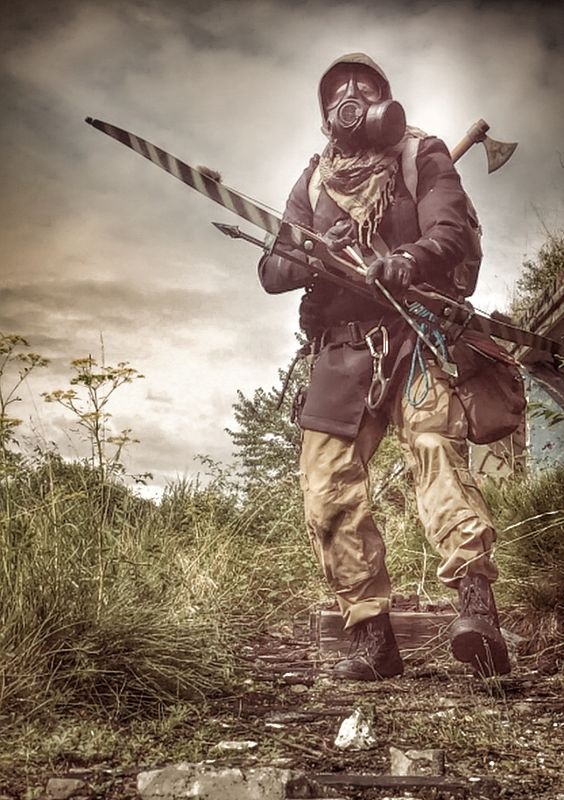
“So I don’t know much about archery, but I’m planning on taking some lessons soon… I believe it’s a great skill to have in any SHTF situation. However, I’m not sure which bow to use between the compound and recurve bow since I’m planning to use only one for now. What would you advise me to use?”
This question – and many others of the same nature – have been flooding our inboxes over the past month. Many folks who have just realized the benefits that come with using archery for SHTF are confused on the right bow to invest in for SHTF use.
If you too are unable to make a decision on the best bow to use for different survival situations, don’t worry. We’ve got your back. We did some extensive research and put up this post to teach you which is the appropriate bow – between a compound and recurve – to use in any SHTF situation.
Let’s dive into the details right away:
Compound Bow vs. Recurve (Traditional) Bow

Via pinterest.com
Both bows share some similarities since they both have strings and arrows – but that’s the end of their similarities.
The compound bow is quite a new, exciting evolution in the bow technology field that has been there for the last few decades. Its modern design allows you to shoot more accurately and for longer.
But that does not mean that the recurve is not any better. Featuring the traditional style, the recurve bow offers you a simplistic as well as a historic advantage. That is, it has an overall lightweight design and does not get bogged down by technology and loads of accessories.
Archers are embroiled in an unending debate on whether a recurve or compound bow is the better for SHTF. The fact is: both bow models present you entirely different pros/cons in all SHTF scenarios.
If you’re having a hard time figuring out which one to buy, here are the real differences between these bows that will help you make an informed decision:
Compound Bow Explained

Via pinterest.com
Compound bows come with longer strings that allow you to pull back as far as you can to produce more power. This helps loosen your hold on your bow given that you won’t need much energy/effort to keep the arrow in the firing position. Overall, this enhances stability, making the bow more powerful and accurate.
And given that this bow features draw spots in the pulley system, you’ll need to apply a consistent amount of force for every shot you make – further enhancing your accuracy. That being said, a compound bow has been proved to be an excellent companion to archers (especially in hunting) given its deadly precision. In fact, it can knock down even the large preys such as bears!
The cams and pulley system that accompany this bow aids in direct control the acceleration of the arrow. Soft cams tend to generate the arrow more gently than the harder ones. If you’re a beginner archer, I’d highly advise you to go for the soft cam.
How does a compound bow behave when it’s drawn? Well, its limbs pull towards each other in a horizontal manner, unlike in the recurve bow where the limbs tend to flex in bow string direction. The slight difference goes a long way in minimizing the recoil and vibration you feel when you release the arrow – making it an excellent choice for beginners.
Recurve Bow Explained

Via pinterest.com
Because of its greater mass, this bow offers you a greater stability which ultimately leads to greater accuracy.
It’s important to note that the accuracy of your bow is directly related to its draw weight and you handle it. For this reason, it’s critical that you avoid overestimating your capabilities (especially if you’re beginner archer) and choose a draw weight that matches up to your body build as well as your level of experience.
When put side by side with a compound, this traditional style bow is not as much powerful and accurate. This stems from the fact that it requires the same amount of force to hold the draw which leads to momentary shakiness and affects accuracy. As such, these bows are best used in the shooting competitions as well as hunting the smaller game.
This bow may lack in power and accuracy, but it compensates you with its interchangeability and ease of use. It’s incredibly easy for you to detach the limbs of this bow from the riser, hence the name takedown bow.
Final Thoughts: Compound vs. Recurve Bow
After learning the essential characteristics and the walking of both bows above, it’s now time to decide which bow works best for you. Let’s make a quick comparison of both arrows below on the following important aspects:
1. Power and accuracy
The compound bow ranks best regarding power and precision. The longer string lest you draw back farther and generate as much power as possible, boosting your accuracy.
As for the recurve, they don’t deliver as much power. They require you to use a lot of energy to hold your draw, which can lead to shakiness and decreased accuracy.
2. Use in SHTF Scenarios
Compound bows work best when used for SHTF scenario such as survival hunting. Given their power, accuracy, and long range, they’ll efficiently take down even the largest of the games.
Recurve are best suited for hunting the smaller game. Though they can also take down the bigger games, the shot placement is quite important. They enjoy a wider usage in shooting competitions.
3. Accessories
There are more accessories available for the compound bows as opposed to the recurve bows. The most common accessories for compound bows include a single pin bow sight (helps you aim more accurately) and the trigger release (makes it easier for you to release your bowstring consistently for a greater deal of accuracy).
You can as well use the above sight with recurve bows, but they tend to be uncommon because archers who use this bow are mainly pursuits who prefer the skill-based experience.
4. Price
Compound bows come with longer strings, larger bodies, and even pulley systems which make their pricing a bit higher than that of the recurve bows which don’t come with complicated mechanisms.
However, it’s possible to come across a compound bow with a similar price to a recurve bow if you’re willing to shop around.
In summary, neither of these arrows is better suited for SHTF situations than the other. Which bow is the best for you boils down to your personal preference, experience, skills, and budget.
Author Bio:
 Jennifer is the founder of BuckWithBow, a great blog that focuses on helping you learn how to hunt deer with a bow. As an experienced bow hunter, she will guide you through the Do’s and Don’ts of the bowhunting world and transform you into a better hunter. Whether you are an experienced bow hunter or an absolute beginner, you will find BuckWithBow a gem!
Jennifer is the founder of BuckWithBow, a great blog that focuses on helping you learn how to hunt deer with a bow. As an experienced bow hunter, she will guide you through the Do’s and Don’ts of the bowhunting world and transform you into a better hunter. Whether you are an experienced bow hunter or an absolute beginner, you will find BuckWithBow a gem!